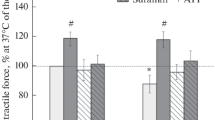Abstract
Experiments on rats showed that carbachol (10 µM) appreciably quickens miniature end-plate potentials in the soleus muscle kept in medium with potassium chloride concentration increased to 13 mM. Potentiation of spontaneous mediator release also took place when the membrane potential of the muscle fibers was clamped at the level of the potassium equilibrium potential. It is concluded that the presynaptic action of carbachol on synaptic liberation of acetylcholine from motor nerve endings is unconnected with depolarization of the postsynaptic membrane but takes place as a result of the direct effect of the mimetic on motor nerve endings.
Similar content being viewed by others
Literature cited
L. G. Magazanik, P. Illes (P. Illesh), and V. A. Snetkov, "Effect of serotonin on potential-dependence of the end-plate current of the muscle fiber," Dokl. Akad. Nauk SSSR,227, No. 5, 1268 (1976).
V. P. Nesterov, "Connection between contractile parameters and distribution of sodium and potassium ions in skeletal muscles of vertebrates," Fiziol Zh. SSSR,60, No. 9, 1186 (1974).
E. E. Nikol'skii and R. A. Giniatullin, "Termination of the presynaptic action of carbachol by tubocurarine," Byull. Éksp. Biol. Med.,87, No. 2, 171 (1979).
S. Ciani and C. Edwards, "The effect of acetylcholine on neuromuscular transmission in the frog," J. Pharmacol.,142, No. 1, 21 (1963).
C. Edwards and K. Ikeda, "Effects of 2-PAM and succinylcholine on neuromuscular transmission in the frog," J. Pharmacol. Exp. Ther.,138, No. 2, 322 (1962).
L. C. Fritz and A. R. Gardner-Medwin, "The effect of synaptic activation on the extracellular potassium concentration in the hippocampal area, in vitro," Brain Res.,112, No. 1, 183 (1976).
J. I. Hubbard, R. F. Schmidt, and T. Yokota, "The effect of acetylcholine upon mammalian motor nerve terminals," J. Physiol. (London),181, No. 4, 810 (1965).
B. Katz, "The transmission of impulses from nerve to muscle, and subcellular unit of synaptic action," Proc. Roy. Soc. (London),155, No. 961, 455 (1962).
M. D. Miyamoto and R. L. Volle, "Enhancement by carbachol of transmitter release from motor nerve terminals," Proc. Natl. Acad. Sci. USA,71, No. 4, 1489 (1974).
F. F. Weight and S. D. Erulkar, "Modulation of synaptic transmitter release by repetitive postsynaptic action potentials," Science,193, No. 4257, 1023 (1976).
Additional information
S. V. Kurashov Medical Institute, Ministry of Health of the RSFSR, Kazan'. Translated from Neirofiziologiya, Vol. 14, No. 2, pp. 185–189, March–April, 1982.
Rights and permissions
About this article
Cite this article
Nikol'skii, E.E. Effect of carbachol on miniature end-plate potentials and currents of rat skeletal muscle. Neurophysiology 14, 148–152 (1982). https://doi.org/10.1007/BF01060186
Received:
Issue Date:
DOI: https://doi.org/10.1007/BF01060186




